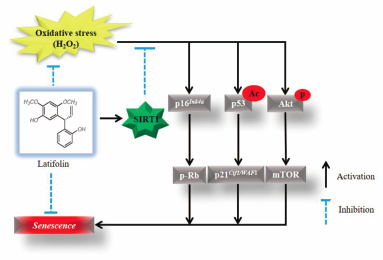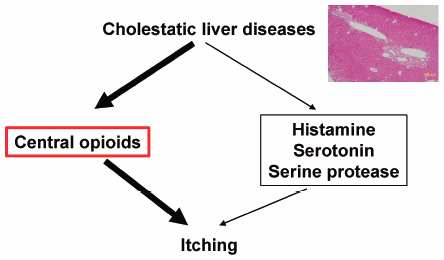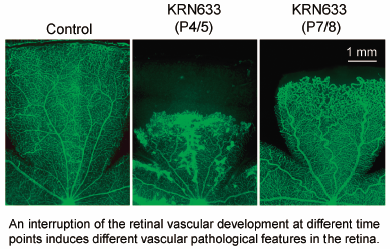-
Editor's pick
Niemann-Pick diseases are classified into types A/B and C and early definitive diagnosis of them is important for better prognosis of the diseases. The authors developed a novel diagnostic screening strategy for Niemann-Pick diseases using a combination of serum concentrations of N-Palmitoyl-O-phosphocholine-serine and sphingosylphosphocholine based on analyses by liquid chromatography/tandem mass spectrometry. In this study, a rapid method and a validated analysis were developed. The former was useful for screening and the latter were useful for differentiation of Niemann–Pick diseases. This strategy may be useful for screening of Niemann-Pick diseases in clinical practice.
-
Volume 43 (2020) Issue 8 Pages 1147-1153Development of Multi-functional Nanoparticles for Clinical Application to Gene and Nucleic Acid Medicines Read moreEditor's pick
The clinical application of gene/nucleic acid medicines is highly dependent on the development of effective and reliable drug delivery systems. Dr. Sasaki successfully developed several ternary complexes as novel gene delivery carriers, which were constructed by gene/nucleic acid medicine, the cationic polymer, and the anionic polymer. This ternary complex consists of biodegradable materials found in foods and medical products that are already in clinical use and can deliver gene/nucleic acid medicines to specific organs (liver, spleen, lung, and cancer cells etc.) without toxicity. The ternary complexes are expected to apply to clinical practice.
-
Volume 43 (2020) Issue 8 Pages 1172-1178Isosteviol Sodium Attenuates High Fat/High Cholesterol-Induced Kidney Dysfunction by Inhibiting Inflammation, Oxidative Stress and Apoptosis Read moreEditor's pick
The sodium salt of isosteviol (STVNa) is a beyerane diterpene synthesized through acid hydrolysis of stevioside. STVNa improves multiple types of tissue injuries. However, it is not known how Isosteviol sodium affects high-fat and high cholesterol diet (HFD)-induced kidney. The current study suggested that STVNa inhibited HFD-induced kidney injury evident by reducing the increased levels of serum CRE. Specifically, STVNa attenuated HFD-induced kidney injury by inhibiting inflammation, oxidative stress, and apoptosis. These findings indicate that STVNa may have a therapeutic potential for metabolic syndrome associated kidney dysfunction by inhibiting inflammation, oxidative stress and apoptosis.
-
Volume 43 (2020) Issue 8 Pages 1188-1195Enhanced Immunostimulatory Activity of CpG Oligodeoxynucleotide by the Combination of Mannose Modification and Incorporation into Nanostructured DNA Read moreEditor's pick
Increasing the immunostimulatory activity of unmethylated cytosine-phosphate-guanine oligodeoxynucleotide (CpG ODN) is an important issue for its clinical application as immunoadjuvant. In this study, the authors combined two approaches, i.e., nanostructured DNA formation and mannose modification, for efficient delivery of CpG ODN to mannose receptor-positive immune cells. Mannosylated CpG ODN (Man-CpG ODN) loaded onto polypod-like structured nucleic acid (polypodna) induced a greater tumor necrosis factor-α release than Man-CpG ODN or CpG ODN/polypodna from the cells. Thus, this study provides a new and promising approach to increasing the therapeutic potency of CpG ODN.
-
Volume 43 (2020) Issue 8 Pages 1248-1252Trends of Antifungal Use Based on Sales Data in Japan from 2006 to 2015 Read moreEditor's pick
The detailed epidemiology of invasive mycoses and superficial mycoses has not been clarified in Japan. This is the first study to clarify the trends of antifungal use in Japan. The authors found that total antifungal use decreased over time. Notably, the trend of antifungal use for invasive mycoses was significantly increased by 19.9% whereas the trend of antifungal use for superficial mycoses significantly decreased by 49.8%. In Japan, the increase in the number of immunocompromised patients might be associated with an increase in the frequency of antifungal use for invasive mycoses.
-
Volume 43 (2020) Issue 8 Pages 1259-1266Development and Testing of an Individual Kernel Detection System for Genetically Modified Soybean Events in Non-identity-preserved Soybean Samples Read moreEditor's pick
Today, majority of soybeans in Japan comes from foreign countries, where genetically modified (GM) soybeans are cultivated. The details of GM soybean actually consumed for food in Japan have been unknown. The article by Soga et al. reported a quantitative GM soybean kernel detection system and that the most of imported soybean in the non-identity-preserved soybean samples examined were herbicide-tolerant and insect-resistant GM soybean events that were authorized in Japan. These data would provide useful information on risk analysis concerning regulations on GM soybean for food use.
-
Volume 43 (2020) Issue 7 Pages 1061-1066Evidence of Passive Smoking as a Risk Factor of High-Grade Squamous Intraepithelial Lesion: A Case-Control Study Read moreEditor's pick
The association between risk factors and occurrence or development of cervical intraepithelial lesions, such as persistent infection with high-risk human papillomavirus (HPV), multiple sexual partners and smoking have been discussed. However, the effect of passive smoking on the disease is unclear. In this case-control study, Du et al. found that passive smoking was a significant independent risk factor on the occurrence of HSIL and showed a positive correlated dose-response relationship. HPV infection interacting with passive smoking led to an even higher disease risk. Adolescent exposure to passive smoking persistent for more than 20 years would also increase the HSIL risk.
-
Volume 43 (2020) Issue 7 Pages 1104-1110Latifolin Inhibits Oxidative Stress-Induced Senescence via Upregulation of SIRT1 in Human Dermal Fibroblasts Read moreEditor's pick
Aging is the most important risk factor for various diseases such as cancer, osteoarthritis, dementia, atherosclerosis, and infection. Therefore, the researchers has attempted to find phytochemicals for ameliorating aging-related diseased. Latifolin, isolated from Dalbergia odorifera T. Chen, has been reported to exhibit anti-inflammatory and anti-carcinogenic activities. In present study, the authors investigated the anti-aging effect of latifolin in human dermal fibroblasts. Modulation of SIRT1 may be involved in latifolin protective effect against H2O2-induced oxidant injury. These results suggest that latifolin supplementation might be a possible route for improving aging and age-related diseases.
-
Volume 43 (2020) Issue 7 Pages 1111-1117Pharmacological Characterization of a Novel Mouse Model of Cholestatic Pruritus Read moreEditor's pick
Patients with cholestatic liver diseases, such as primary biliary cirrhosis, usually suffer from pruritus. However, the pathogenesis of cholestatic pruritus is unclear, and there is no current effective treatment for it. In order to find a treatment for the condition, an appropriate mouse model should be developed. Andoh et al. established a surgically-induced mouse model of cholestatic pruritus and evaluated anti-pruritic effects of several drugs using this mouse model. In results, they suggested that partial obstruction of bile secretion in mice induced anti-histamine-resistant itching and that central opioid system is involved in cholestatic itching.
-
Volume 43 (2020) Issue 7 Pages 1118-1122Single Molecule Fluorescence Imaging Reveals the Stoichiometry of BKγ1 Subunit in Living HEK293 Cell Expression System Read moreEditor's pick
Large conductance Ca2+-activated K+ (BKCa) channels possess significant physiological functions in various types of cells. The stoichiometry between BKa and newly identified ɤ1 subunits (BKɤ1) remains unclear. Here, the authors utilized a single molecule fluorescence imaging with a total internal reflection fluorescence (TIRF) microscope to directly count the number of GFP-tagged BKɤ1 within a single BKCa channel complex in HEK293 expression system. Counting of GFP bleaching steps revealed that a BKCa channel contains mainly four BKɤ1 per channel. These results suggest that BKɤ1 forms a BKCa channel complex with BKa in a 1:1 stoichiometry in a human cell line.
-
Volume 43 (2020) Issue 6 Pages 932-937Ziyuglycoside II Inhibits Rotavirus Induced Diarrhea Possibly via TLR4/NF-κB Pathways Read moreEditor's pick
In the present study, Ziyuglycoside II inhibits rotavirus (RV) induced diarrhea via toll-like receptor 4 (TLR4)/nuclear factor kappa-B (NF-κB) signaling pathway. Ziyuglycoside II inhibited the proliferation of MA104 cells infected with RV via suppressing RV duplication. The combination of Ziyuglycoside II and Ribavirin protected against RV-induced diarrhea through regulating TLR4/NF-κB signaling pathway. Moreover, the combined treatment suppressed the level of pro-inflammation cytokines and overexpressed anti-inflammation cytokine. Moreover, the combined therapy improved the lesion changes and inhibited the cell apoptosis in vivo. Thus Ziyuglycoside II may function as protective role in RV-induced diarrhea.
-
Volume 43 (2020) Issue 6 Pages 959-967Characterization and Immunological Activities of Polysaccharides from Polygonatum sibiricum Read moreEditor's pick
Polygonatum sibiricum first appeared in ancient Chinese medicine books around 1000 years ago and is used to tonify the spleen and nourish the lungs. The authors present here a kind of natural polysaccharides (PSP) extracted from Polygonatum sibiricum were purified, characterized and assayed both in vitro and in vivo for its immunomodulatory activity and mechanism. It is of interest to note that PSP not only regulated the immune function of normal mice, but participated in the protection against immunosuppression in cyclophosphamide-treated mice, highlighting its potential as an immunostimulant.
-
Volume 43 (2020) Issue 6 Pages 968-975Potential Mechanisms Underlying the Hepatic–Protective Effects of Danshensu on Iron Overload Mice Read moreEditor's pick
Danshensu (3-(3,4-dihydroxyphenyl)-(2R)-lactic acid) is one of the water-soluble active ingredients of Salvia miltiorrhizae, a traditional Chinese medicine for the treatment of cardiovascular diseases. This study investigated the protective effects of Danshensu on the acute liver injury induced by iron overload in mice. The results indicated that the underlying mechanisms at least partly involve anti-oxidation, anti-inflammation, anti-apoptosis, and decreasing hepatic iron deposition possibly through down-regulating the expression of iron uptake related proteins, such as DMT1, TfR, and L-type Ca2+ CP α1C. Therefore, they conclude Danshensu could be a promising prophylactic or therapeutic agent for iron overload diseases.
-
Volume 43 (2020) Issue 6 Pages 1007-1015Detection of Abacavir-Induced Structural Alterations in Human Leukocyte Antigen-B*57 : 01 Using Phage Display Read moreEditor's pick
The interaction of human leukocyte antigen (HLA) with specific drugs induces structural alteration in HLA and delayed-type hypersensitivity reactions, which cause severe cutaneous toxicity. Shirayanagi et al. selected specific phage antibodies able to recognize HLA-B*57:01 and evaluated structural alterations in HLA-B*57:01 complexes induced by abacavir. The affinity of selected phage antibodies increased because of structural alterations in HLA-B*57:01 following exposure to abacavir, indicating that specific phage antibodies can identify drug-mediated structural changes in HLA complexes. These results suggest that phage display technology is a useful method for detecting structural changes in HLA complexes.
-
Volume 43 (2020) Issue 5 Pages 823-830Predicting Method for the Human Plasma Concentration–Time Profile of a Monoclonal Antibody from the Half-life of Non-human Primates Read moreEditor's pick
Efficiency and animal welfare are important factors in the development of new drugs. Considering this, Nakamura et al. propose a new way of predicting human PK for mAbs that is more efficient than conventional methods. By collecting mAb PK data on linear elimination and analyzing a two-compartment model, they revealed that half-life during elimination is the main contributor to plasma clearance. Based on this feature, they developed a novel method that uses easy-to-obtain parameters from humans and non-human primates to predict human PK. Called the half-life method, it can improve animal welfare and potentially accelerate the drug development process.
-
Volume 43 (2020) Issue 5 Pages 839-847Ethenzamide Exerts Analgesic Effect at the Spinal Cord via Multiple Mechanisms of Action Including the 5HT2B Receptor Blockade in the Rat Formalin Test Read moreEditor's pick
Ethenzamide (ETZ) is widely used as an OTC pain reliever, however, its site of action and mechanism underlying its analgesic action had not yet been fully elucidated. The article by Nikaido et al. provides evidence suggesting that the analgesic effect of ETZ in the rat formalin test was mediated by multiple mechanisms of action including the 5-hydroxytryptamine2B receptor blockade at the spinal cord.
-
Volume 43 (2020) Issue 5 Pages 859-863Abnormal Vascular Phenotypes Associated with the Timing of Interruption of Retinal Vascular Development in Rats Read moreEditor's pick
Pathological angiogenesis is a leading cause of blindness in several retinal diseases. Kondo et al. demonstrated that only a 2-day treatment of neonatal rats with the VEGF receptor tyrosine kinase inhibitor at different time points could induce abnormal blood vessels with different vascular pathological features (intravitreal neovascularization vs. tortuous arteries) in the retina. Pharmacological agents targeting the VEGF signaling pathway are useful for creating an abnormal retinal vasculature with various pathological features in order to study the mechanisms underlying abnormal retinal angiogenesis and evaluate the efficacy of anti-angiogenic compounds.
-
Volume 43 (2020) Issue 5 Pages 873-878Cancer Cachexia May Hinder Pain Control When Using Fentanyl Patch Read moreEditor's pick
The transdermal fentanyl patch (FP) has been used worldwide to relieve cancer pain. However, no previous studies have examined the influence of cancer cachexia on pain control in cancer patients receiving FP treatment. Chiba et al. found that cancer cachexia may be a risk factor for poor pain control in patients receiving FP treatment, and that uncontrolled pain in FP treatment may be caused by the inhibition of fentanyl transdermal absorption due to dry skin.
-
Volume 43 (2020) Issue 5 Pages 898-903Fluorinated Kavalactone Inhibited RANKL-Induced Osteoclast Differentiation of RAW264 Cells Read moreEditor's pick
To discover small molecules that affect osteoclastogenesis, Kumagai et al designed and synthesized styrylpyrone analogs, and discovered (E)-6-(2-fluorostyryl)-4-methoxy-2H-pyran-2-one (22) has osteoclast-inhibitory activities in murine RAW264 cells. A partial structure-activity relationship revealed that fluorine and its position within the styrylpyrone skeleton were important. Authors also revealed that compound 22 prevents osteoclastic bone resorption by inhibiting osteoclastogenesis. Compound 22 downregulated mRNA expression levels of RANKL-induced nuclear factor of activated T cells c1 (NFATc1) and osteoclastogenesis-related genes. These findings may be useful for the desigh of antiresorptive agents for the treatment of bone disorders characterized by excessive osteoclastic activity .
-
Editor's pick
The 34th Annual Meeting of the Academy of Pharmaceutical Sciences and Technologies, Japan (APSTJ) was held in Toyama, Japan, May 16–18, 2019. In this meeting, a joint symposium was held with the Pharmaceutical Society of Japan and APSTJ. The theme of the symposium was “Recent Advances in Research on Particulate Formulations such as Lipoproteins, Liposomes, Extracellular Vesicles, and iPS Derived Cells.” The four invited speakers provide their review articles in the Current Topics of this issue.


















